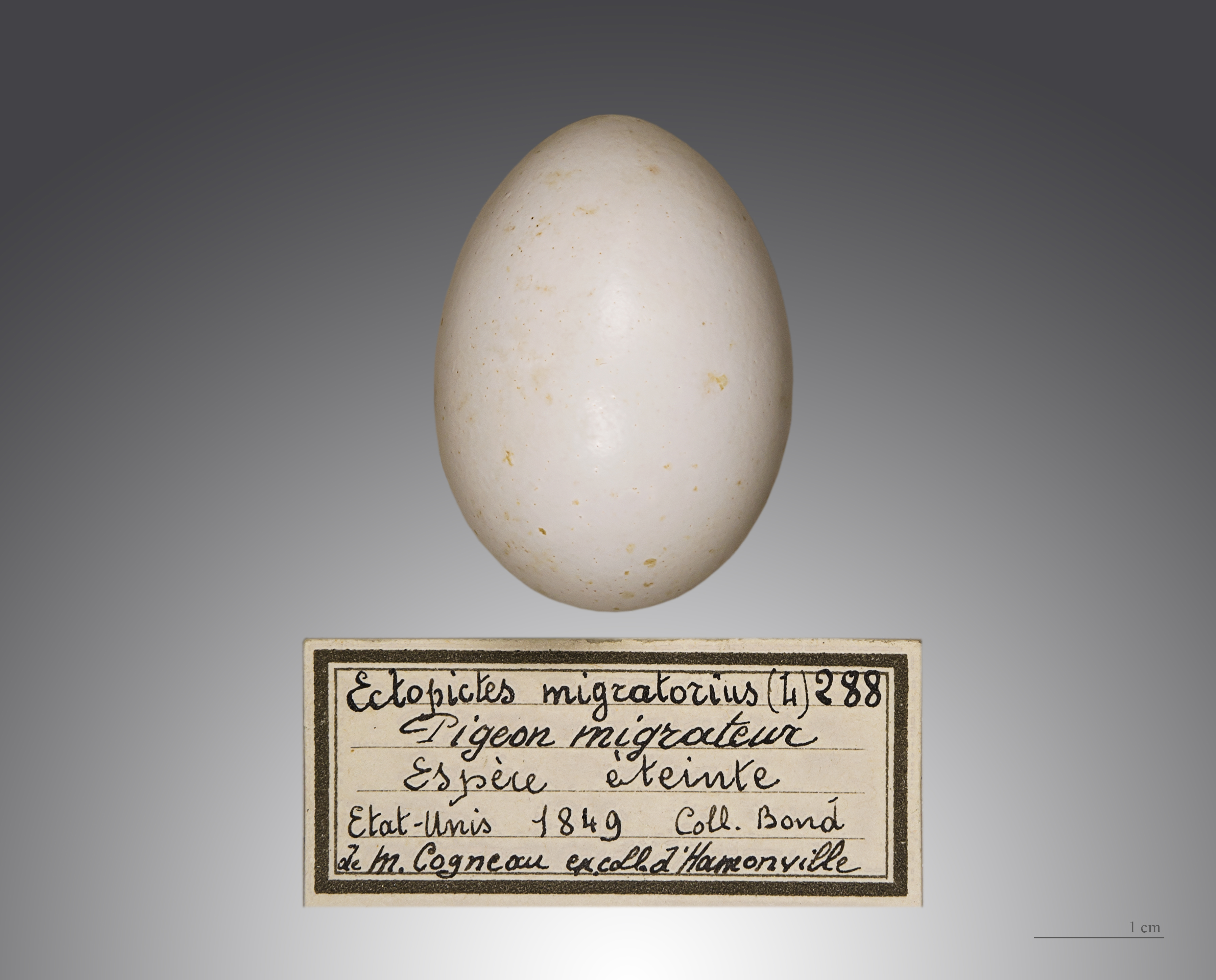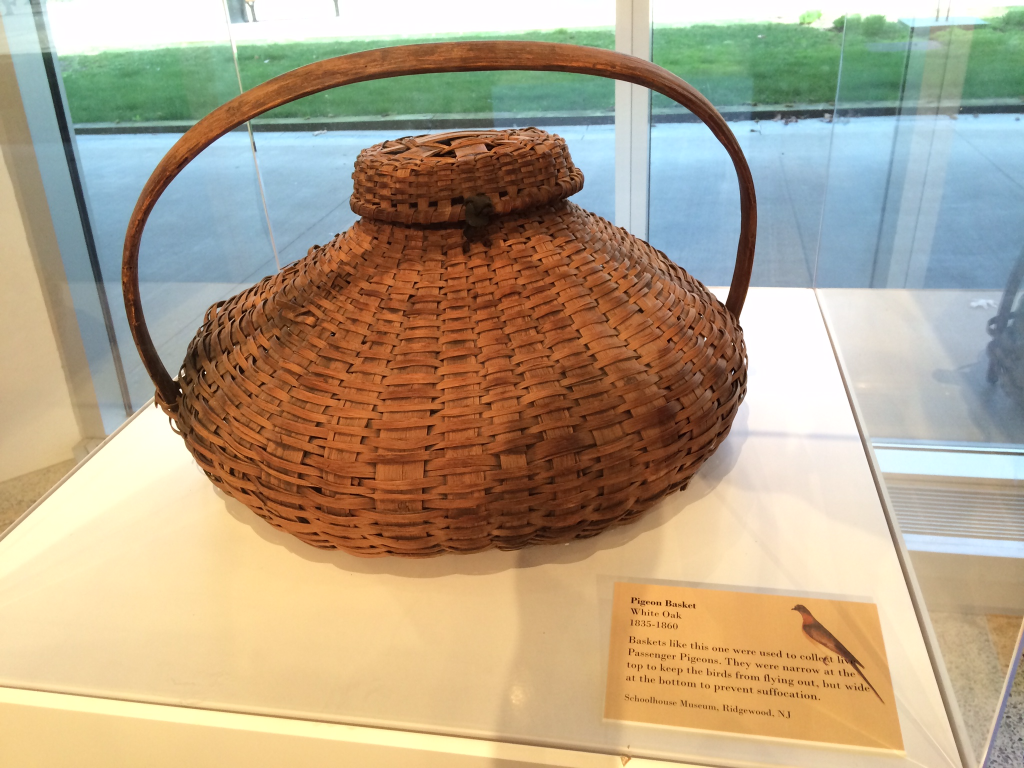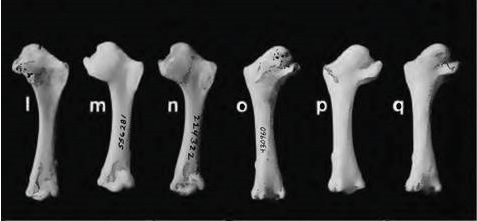Category: Passenger Pigeon
Annie Alexander’s Contribution to Passenger Pigeon Research
An eyewitness account of trapping passenger pigeons in New Jersey in the early 1800s is one of only two publications by the woman who founded one of the premier paleontological museums in America.
In 1927, a short communication was published in the journal The Condor that quoted a letter from John Thomas Waterhouse to his parents back in England. Waterhouse described how the New Jerseyans hunted passenger pigeons using nets and guns.
“An extraordinary bird of great size and beauty”

Mecca Cigarettes trading card from the early 1900s. “The young birds are very fat and their flesh is delicious.”
Can Six Eggs Show Whether Passenger Pigeons Became Functionally Extinct?

David L. Roberts, Ivan Jarić and Andrew R. Solow, attempt to test the hypothesis that passenger pigeon became functionally extinct, “defined as permanent reproductive failure prior to true extinction” (p. 3) before their actual extinction in the wild around 1902.
Martha, the last captive passenger pigeon, of course, survived until 1914, and you could say that the passenger pigeon truly became functionally extinct by 1910 when George, the last captive male pigeon died. Roberts and colleagues, however, are trying to test a hypothesis some researchers have raised in recent years, that wild passenger pigeons needed to gather in enormous flocks to reproduce successfully. According to this argument, once those great nestings were no longer possible because of overhunting and harassment at the nesting sites by humans, the passenger pigeon was doomed to extinction, even though many thousands of them were still alive.
Therefore, it’s interesting that, based on their statistical test, the authors conclude that the passenger pigeon actually was not functionally extinct. I’ll leave it to mathematicians to evaluate the actual statistical method, but a big question is whether the data they used in their study is robust enough to support that conclusion. That data is records of eggs and skins in museum collections across the world (obtained from the Ornis2 database) collected between 1825 and 1900, with most of the samples from roughly the 1860s to 1890s. Their sample consists of 213 skins and 44 eggs. For reasons that are not clear in the article, they further reduce their sample to specimens collected from 1890 onwards (the “observation period”). Their sample size? Twenty-seven skins and six eggs. Unaddressed is the issue of data quality. The museum specimens were not systematically collected and really can’t be considered a random sample representative of the wild population at the time. The data in Ornis2 also may not be complete; there is an egg collected in Minnesota in 1895 (see Greenberg), for example, that is not included in the six eggs from the 1890s used in their study.
It is important to develop new methods of studying extinction, and if this work does that, it will be valuable, but I caution against putting too much weight on the conclusion regarding the extinction of the passenger pigeons.
On the functional extinction of the Passenger Pigeon (accepted manuscript in Conservation Biology)
The Video Rental Store/Passenger Pigeon Connection
It’s just a passing simile, but reviewer Joe Hill compares video rental stores, ubiquitous just a decade or two ago, with passenger pigeon flocks in his review of the book Universal Harvester, a mystery of sorts by lead Mountain Goat John Darnielle.
Was the disappearance of video rental stores from the American landscape a sudden, overnight event, or were there clues that their demise was coming? That question played out on a smaller scale in the first episode of Starlee Kine’s first episode of the Mystery Show podcast, which itself now appears to be as extinct as the passenger pigeon. What is not extinct, however, is the video rental store. In fact, the largest video rental store is thriving, with 759 stores in the Midwestern U.S. and in Canada.
3D Printing of Passenger Pigeon “Artifictions”
Just published and open access is a new article that demonstrates the value and potential of 3D scanning and printing for osteological identification of passenger pigeons and other extinct or rare animals.
Some zooarchaeologists have been producing 3D images of animal bones for a while now. This article describes the next step, the creation of actual physical replicas (which they dub “artifictions”, as opposed to artifacts) using 3D printers. The practical goal is to increase the reliable identification of animal species (especially rare or difficult to distinguish ones) in archaeological faunal assemblages, which now is dependent on the zooarchaeologist having ready access to a large and varied collection of actual animal skeletons. Why aren’t digital representations of bones enough?
because the scale of digital models is based on the size of the screen upon which they are viewed, making identifications by direct comparison difficult. Artifictions, however, can be scaled accurately and physically placed alongside actual skeletal elements to enable more direct visual comparison and identifica-tion of specimens, comparable to the use of a reference specimen from a comparative skeletal collection. Additionally, the 3D scanned models can be used for species identification based on selected point-to-point morphometric measurements. (p. 16)
For examples, the authors use the passenger pigeon and the harelip sucker, a freshwater fish that, like the passenger pigeon, went extinct near the beginning of the twentieth century.
While there are still some technical (and budgetary) limitations with the 3D printing process, they argue convincingly that “this is the only non-commercial approach that will make available physical representations of skeletal elements from extinct species for quick distribution to a large number of researchers.” (p. 19) Efforts are underway to make these models available for download. Next, somebody needs to buy me a 3D printer.
Reference:
Manzano, Bruce L., Bernard K. Means, Christopher T. Begley, and Mariana Zechini
2015 Using Digital 3D Scanning to Create “Artifictions” of the Passenger Pigeon and Harelip Sucker, Two Extinct Species in Eastern North America: The Future Examines the Past. Ethnobiology Letters 6(2):15-24.
Basket for Storing Live Passenger Pigeons

This mid-nineteenth century basket, on display as part of the passenger pigeon exhibit at the New Jersey State Museum, is on loan from the Schoolhouse Museum in Ridgewood, NJ. It is similar to a stool pigeon basket shown in French’s The Passenger Pigeon in Pennsylvania.
The Oldest Passenger Pigeon Fossil
How old is the earliest passenger pigeon fossil? A single wing bone found at the Lee Creek Mine paleontological locality in North Carolina is 3.7 to 4.8 million years old, a time period known as the Early Pliocene. It is reasonable to ask whether a fossil that old is from the same species as the historically known passenger pigeon, and the paleontologists who identified it were cautious, officially labeling the humerus bone Ectopistes aff. migratorius, but also stating that “Apart from the slightly larger size, which probably would have been encompassed by variation in the recent species, the fossil shows no distinguishing differences from E. migratorius.” (Olson and Rasmussen 2001:300).
The thousands of other fossil bird bones found here were originally deposited in deep marine water and in fact most of the identified birds are ocean-going species like auks, shearwaters, and albatrosses. Land based birds (including the passenger pigeon) comprise a very small proportion of the assemblage (Olson and Rasmussen 2001).

Reference:
Olson, Storrs L., and Pamela C. Rasmussen
2001 Miocene and Pliocene birds from the Lee Creek Mine, North Carolina. Smithsonian Contributions to Paleobiology 90:233-365.
Northernmost Passenger Pigeon Fossils Found Near Site of Controversial Dam Project
A controversial dam and reservoir planned for British Columbia, Canada, is expected to flood over 12,000 acres (5000 hectares) of land in the Peace River valley. The Peace River Valley is home to Charlie Lake Cave (also known as Tse’K’wa), where archaeologist Jonathan Driver identified what may be the northernmost passenger pigeon fossils ever found. Charlie Lake Cave is just north of 56° latitude on the eastern side of the Canadian Rockies. Passenger pigeon bones were found in a level dated between 9,000-8,100 years ago, as well as in younger deposits.
While this site is not directly threatened by the Site C dam, hundreds of other archaeological and paleontological sites will be flooded by the BC Hydro project. Local First Nation tribes and other residents are also opposed to the project.
For more information, see The Globe and Mail story.
For more on Charlie Lake Cave, including video interviews with Jon Driver, check out A Journey to a New Land, created by the Simon Fraser University Museum of Archaeology and Ethnology
Reference:
Driver, Jonathan C., and Keith A. Hobson
1992 A 10 500-year sequence of bird remains from the Southern Boreal Forest region of western Canada. Arctic 45(2):105-110.

John Lawson on Passenger Pigeons in Carolina
John Lawson arrived in Charleston, South Carolina, in 1700. At the end of the year, he set off with nine other people on a two month long excursion through South and North Carolina, arriving on the Pamlico River on the 24th of February, 1701. Along the way, they encountered passenger pigeons more than once. On one occasion, after crossing a river, they “saw several Flocks of Pigeons, Field-Fares, and Thrushes.” (1709:42) Several days later, while waiting for one of the men to return with some horses that had run off, the others
went to shoot Pigeons, which were so numerous in these Parts, that you might see many Millions in a Flock; they sometimes split off the Limbs of stout Oaks, and other Trees, upon which they roost o’ Nights. You may find several Indian Towns, of not above 17 Houses, that have more than 100 Gallons of Pigeons Oil, or Fat; they using it with Pulse, or Bread, as we do Butter, and making the Ground as white as a Sheet with their Dung. The Indians take a Light, and go among them in the Night, and bring away some thousands, killing them with long Poles, as they roost in the Trees. At this time of the Year, the Flocks, as they pass by, in great measure, obstruct the Light of the day.(1709:44-45)
When Lawson wrote his book several years later, he incorporated additional knowledge he had obtained about the Carolinas. According to Lawson, pigeons did not breed along the coast of the Carolinas (“They leave us in the Summer.” 1709:140), but large flocks did roost there during the winter. He intimates that the size of these flocks could vary by year, with a particularly large number of pigeons seen in 1707, “the hardest Winter that ever was known” (1709:141) in Carolina. Yet these flocks paled in comparison to “the great and infinite Numbers of these Fowl, that are met withal about a hundred, or a hundred and fifty, Miles to the Westward of the Places where we at present live; and where these Pigeons come down, in quest of a small sort of Acorns” (1709:141)
Recalling his winter expedition, he wrote how
such prodigious Flocks of these Pigeons…had broke down the Limbs of a great many large Trees all over those Woods, whereon they chanced to sit and roost; especially the great Pines, which are a more brittle Wood, than our sorts of Oak are. These Pigeons, about Sun-Rise, when we were preparing to march on our Journey, would fly by us in such vast Flocks, that they would be near a Quarter of an Hour, before they were all pass’d by; and as soon as that Flock was gone, another would come; and so successively one after another, for great part of the Morning. (1709:141)
These flocks may have been traveling from roosts to feeding areas, or may have been working their way north to nesting grounds. Lawson asked the local natives “where it was that those Pigeons bred, and they pointed towards the vast Ridge of Mountains, and said, they bred there.” (1709:142)
References:
Lawson, John
1709 A New Voyage to Carolina; Containing the Exact Description and Natural History of That Country: Together with the Present State Thereof. And A Journal of a Thousand Miles, Travel’d Thro’ Several Nations of Indians. Giving a Particular Account of Their Customs, Manners, &c. London.
Powell, William S., ed.
John Lawson, 1674-1711. In Dictionary of North Carolina Biography. The University of North Carolina Press. http://docsouth.unc.edu/nc/lawson/bio.html
